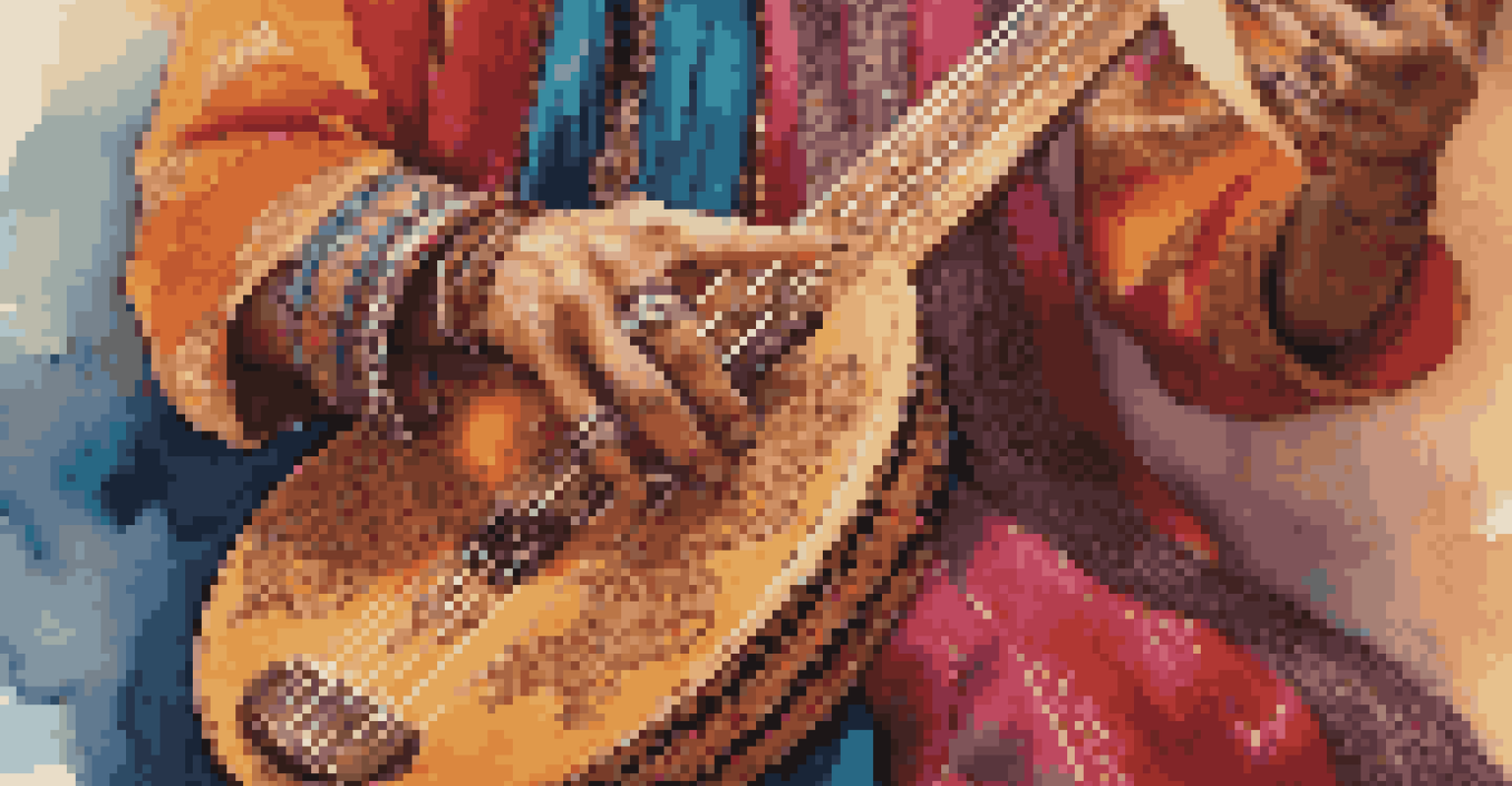Cultural Appropriation in Music: Case Studies and Examples

Defining Cultural Appropriation in Music
Cultural appropriation in music refers to the adoption of elements from one culture by artists from another, often without understanding its significance or history. This practice can lead to the commodification of cultural expressions, reducing them to mere trends. While music has always borrowed and blended influences, the line between appreciation and appropriation can be blurry, making it a complex topic.
Cultural appropriation is the taking of cultural elements from a marginalized group without permission and often without understanding.
A clear example is when mainstream artists incorporate musical styles from marginalized communities without acknowledging their origins. This can lead to a sense of erasure for the original creators, who may not receive recognition or compensation for their contributions. Thus, understanding the nuances of cultural appropriation is essential for artists and listeners alike.
In essence, cultural appropriation can be viewed as a power dynamic where the dominant culture takes from a marginalized culture, often resulting in exploitation. As we delve deeper into specific case studies, we will uncover how these dynamics play out in various musical contexts.
The Impact of Cultural Appropriation on Marginalized Artists
For many marginalized artists, cultural appropriation can feel like a double-edged sword. On one hand, the mainstream success of their cultural elements may bring visibility; on the other, it often leads to their voices being sidelined. This can create a frustrating cycle where the original artists struggle for recognition while others profit from their cultural heritage.

Take the case of hip-hop, which originated in African American and Latino communities. Artists from these backgrounds often face barriers in the music industry, while non-Black artists can achieve fame and fortune by adopting the style. This disparity not only highlights the inequalities present in the music industry but also raises questions about authenticity and ownership.
Understanding Cultural Appropriation
Cultural appropriation in music often involves borrowing elements from marginalized cultures without acknowledgment, leading to exploitation and erasure of original creators.
The emotional toll on original artists can be significant, as they witness their culture being diluted or misrepresented. This underscores the importance of giving credit where it's due and ensuring that the voices of marginalized communities are amplified, not overshadowed.
Case Study: Elvis Presley and Rock 'n' Roll
Elvis Presley is often referred to as the 'King of Rock 'n' Roll,' but his rise to fame also sparked conversations about cultural appropriation. While he undeniably brought rock music to a broader audience, much of his sound was rooted in African American musical traditions, including rhythm and blues and gospel. The question arises: did Elvis appropriately honor these influences, or did he appropriate them?
Art is a reflection of culture, and when it comes to borrowing, it’s crucial to give credit where credit is due.
Many argue that Elvis's success overshadowed the Black artists who pioneered the genre, such as Chuck Berry and Little Richard. These artists laid the groundwork for rock 'n' roll yet received far less recognition during their time. This case exemplifies how cultural appropriation can perpetuate racial inequalities in the music industry, leading to a lack of acknowledgment for original creators.
Ultimately, Elvis's legacy serves as a reminder of the complexities surrounding cultural exchange in music. It invites us to reflect on how we celebrate musical influences while recognizing and respecting the contributions of those who came before.
Case Study: Katy Perry and 'This Is How We Do'
Katy Perry's 2013 song 'This Is How We Do' faced criticism for its perceived cultural appropriation. The music video features elements from various cultures, including Asian and African motifs, which sparked debates about the use of cultural symbols without context. Critics argued that such representations risk trivializing the cultures being borrowed from, reducing them to mere aesthetic choices.
This case illustrates the fine line between cultural appreciation and appropriation. While Perry may have intended to celebrate diversity, the lack of depth and understanding in her portrayal led to accusations of insensitivity. It emphasizes the responsibility artists have when engaging with cultures outside their own.
Impact on Marginalized Artists
For marginalized artists, cultural appropriation can result in their cultural contributions being sidelined while others profit from their heritage.
Moreover, this incident prompted discussions about the need for artists to be more aware and respectful of the cultural elements they incorporate in their work. It serves as a reminder that music can be a powerful tool for inclusivity, but it must be approached thoughtfully to avoid reinforcing stereotypes.
The Influence of Social Media on Cultural Appropriation Awareness
In recent years, social media has played a crucial role in raising awareness about cultural appropriation in music. Platforms like Twitter and Instagram allow fans and cultural critics to voice their opinions and hold artists accountable for their actions. This immediate feedback loop creates a space for dialogue that wasn't as accessible in the past.
For instance, when artists are called out for appropriative behavior, it often leads to widespread discussions and can impact their careers. This shift in accountability reflects a growing recognition of the importance of cultural sensitivity in the music industry. It also empowers marginalized voices, allowing them to share their perspectives and experiences more broadly.
However, social media can also lead to cancel culture, where artists face backlash without room for dialogue or growth. This highlights the need for constructive conversations about cultural appropriation rather than punitive measures. Ultimately, social media serves as both a platform for accountability and a space for education, fostering a more nuanced understanding of cultural exchange.
Navigating Cultural Exchange vs. Cultural Appropriation
As the lines between cultural exchange and cultural appropriation blur, it's essential to navigate this territory with care. Cultural exchange involves mutual respect and acknowledgment, where both parties benefit and honor each other's contributions. In contrast, appropriation often overlooks the origins and significance of the borrowed elements, leading to exploitation.
To foster healthy cultural exchange, artists should strive to educate themselves about the cultures they wish to engage with. This includes understanding the historical context and significance of the music or symbols they are incorporating. By doing so, they can create a more authentic and respectful representation of those influences.
Navigating Cultural Exchange Carefully
Healthy cultural exchange requires mutual respect and understanding, enabling artists to honor the origins of influences while fostering inclusivity in the music industry.
Moreover, collaborating with artists from the cultures being represented can not only enhance the music but also ensure that the original creators are acknowledged and celebrated. This approach promotes a more inclusive music industry, where diverse voices can thrive together.
The Future of Cultural Appropriation in Music
Looking ahead, the conversation around cultural appropriation in music will likely continue to evolve. As society becomes more aware of these issues, artists may feel increased pressure to navigate cultural influences thoughtfully. This shift could lead to a more respectful and inclusive music landscape, where appreciation takes precedence over appropriation.
Additionally, educational initiatives focusing on cultural sensitivity and awareness can empower artists to make informed decisions. By providing resources and fostering discussions around cultural heritage, the music industry can help create a more equitable environment for all artists, regardless of their background.

Ultimately, the future of music lies in collaboration and mutual respect. By embracing diversity and honoring the origins of cultural influences, artists can create a rich tapestry of sounds that celebrates rather than exploits. This approach not only benefits the artists but also enriches the music for listeners around the world.